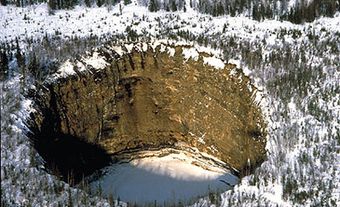Cave
A roofed rock cavity of natural origin, accessible from the surface and large enough for human entry. Caves occur in all kinds of rocks and in every geographical region. The scientific study of caves is called speleology; spelunking is the exploration of caves as a hobby.
Origins
Lava tube caves, an important minor class, are formed by channelled outflow of molten lava in congealing flows. Sea caves most commonly result from erosion by waves. Most known caves, including the largest, longest and deepest, are created by subsurface waters dissolving passageways in soluble rocks, principally limestone. Limestone caves develop along or down natural rock partings, such as joints or bedding planes. Over time, subsurface water may enlarge the diameter of passages in the partings from micrometres to metres or tens of metres. The natural beauty of caves is greatly enhanced by their secondary mineral deposits, principally stalactites, stalagmites and flowstones of calcite, a reprecipitate of dissolved limestone.
Forms
Cave systems comprise interlinked passages and shafts that drain water from upland KARST LANDFORMS to SPRINGS at the limestone boundary. In cross-section, caves display 3 basic forms: phreatic passages (roughly circular dissolved by water under pressure filling all the openings); vadose passages (roofed canyons carved by ordinary gravitational streams in airfilled openings); breakdown forms (parts of the walls or ceilings having fallen). Many caves contain individual chambers far larger than any constructed by humans.
Longest Caves
The Mammoth Cave-Flint Ridge System in Kentucky, US, is the longest known. More that 500 km of interconnected passages are mapped there. Other caves in Switzerland, the US and Ukraine exceed 100 km. Canada's longest known, Castleguard Cave in Banff National Park, has 23 km of galleries passing far beneath the COLUMBIA ICEFIELD.
Deepest Caves
Several caves in the Alps, Caucasus, Pyrenees and Mexico have now been explored to a depth of over 1500 m. Arctomys Cave, in the Rocky Mountains, is Canada's deepest, at 560 m underground.
Life in Caves
Caves trap sediment, flora and fauna, thus preserving natural historic records. Most of our knowledge of human cultural evolution before the last 10 000 years comes from cave dwellings (see PREHISTORY). Many varieties of insects, fishes, birds and mammals live in caves, some adapting to the total darkness by losing their eyes and pigmentation.

 Share on Facebook
Share on Facebook Share on X
Share on X Share by Email
Share by Email Share on Google Classroom
Share on Google Classroom




